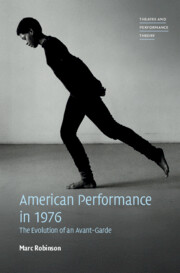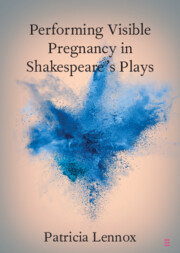Refine search
Actions for selected content:
866 results
Chapter 5 - Personal Religious Experience in Theoric Contexts
- from Part I - Contexts and Perspectives
-
-
- Book:
- Personal Religion in the Ancient Greek World
- Published online:
- 25 November 2025
- Print publication:
- 11 December 2025, pp 119-140
-
- Chapter
- Export citation

Theatre and Censorship in France from Revolution to Restoration
-
- Expected online publication date:
- November 2025
- Print publication:
- 18 December 2025

Empire, Extraction and Power in the Festivals of Britain of 1951 and 2022
-
- Published online:
- 30 November 2025
- Print publication:
- 31 December 2025
-
- Element
- Export citation
Public revolutionaries, private conservatives: rock performances of leftist political thought
-
- Journal:
- Popular Music , First View
- Published online by Cambridge University Press:
- 28 November 2025, pp. 1-16
-
- Article
-
- You have access
- Open access
- HTML
- Export citation

American Performance in 1976
- The Evolution of an Avant-Garde
-
- Published online:
- 27 November 2025
- Print publication:
- 11 December 2025
7 - Conclusion
-
- Book:
- Judging under Constraint
- Published online:
- 27 October 2025
- Print publication:
- 13 November 2025, pp 257-287
-
- Chapter
- Export citation

Performing Visible Pregnancy in Shakespeare's Plays
-
- Published online:
- 11 November 2025
- Print publication:
- 04 December 2025
-
- Element
- Export citation
4 - Communicating the Message
- from Part II - The World of the Text
-
- Book:
- The Gospel of Truth
- Published online:
- 23 October 2025
- Print publication:
- 06 November 2025, pp 76-105
-
- Chapter
- Export citation
6 - Performing Law
- from Part III - Public Tribunals of Judgment
-
- Book:
- Moral Autopsy
- Published online:
- 18 November 2025
- Print publication:
- 30 October 2025, pp 216-237
-
- Chapter
- Export citation

The Archives and Afterlives of Nautch Dancers in India
-
- Published online:
- 24 October 2025
- Print publication:
- 13 November 2025
Deyiş in transmission: Alevi poetry and music as religious tradition
-
- Journal:
- New Perspectives on Turkey , First View
- Published online by Cambridge University Press:
- 23 October 2025, pp. 1-20
-
- Article
-
- You have access
- Open access
- HTML
- Export citation
Chapter 35 - Performing Michael Field
- from Part V - Afterlives and Future Fields
-
-
- Book:
- Michael Field in Context
- Published online:
- 03 October 2025
- Print publication:
- 25 September 2025, pp 333-339
-
- Chapter
- Export citation
Adaptation of rice (Oryza sativa L.) genotypes in the rainfed uplands of southern Laos
-
- Journal:
- Experimental Agriculture / Volume 61 / 2025
- Published online by Cambridge University Press:
- 19 September 2025, e24
-
- Article
-
- You have access
- Open access
- HTML
- Export citation
Chapter 1 - The Personified Will
-
- Book:
- The Will in English Renaissance Drama
- Published online:
- 04 September 2025
- Print publication:
- 18 September 2025, pp 32-62
-
- Chapter
- Export citation
Performance Pedagogy: Theatrical Judgment and Global Citizenship
- Part of
-
- Journal:
- Public Humanities / Volume 1 / 2025
- Published online by Cambridge University Press:
- 04 September 2025, e133
-
- Article
-
- You have access
- Open access
- HTML
- Export citation
31 - Strategic planning and sustainability
- from Part 6 - Shapes Systems
-
-
- Book:
- Leading and Managing Health Services
- Published online:
- 15 August 2025
- Print publication:
- 28 August 2025, pp 358-368
-
- Chapter
- Export citation
Chapter 10 - Governance Shifts and Short-term Performance
- from Part II - Deviating from Plans
-
-
- Book:
- Cambridge Handbook of Project Behavior
- Published online:
- 22 November 2025
- Print publication:
- 28 August 2025, pp 158-168
-
- Chapter
- Export citation
Investigating relationships between performance and workload in CAD tasks
-
- Journal:
- Proceedings of the Design Society / Volume 5 / August 2025
- Published online by Cambridge University Press:
- 27 August 2025, pp. 2161-2170
-
- Article
-
- You have access
- Open access
- HTML
- Export citation
“How to conform to the political jungle”: Organizational politics, social capital, and employee performance
-
- Journal:
- Journal of Management & Organization , First View
- Published online by Cambridge University Press:
- 26 August 2025, pp. 1-23
-
- Article
-
- You have access
- Open access
- HTML
- Export citation
8 - Lords of the Mic
- from Part III - Applications of Rap
-
-
- Book:
- The Cambridge Companion to Global Rap
- Published online:
- 25 July 2025
- Print publication:
- 14 August 2025, pp 127-143
-
- Chapter
- Export citation
